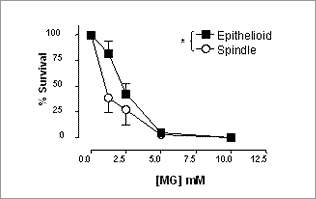The effect of methylglyoxal on the survival of phenotypically distinct vascular smooth muscle cells Vascular smooth muscle cells (VSMC) play a central role in the development of atherosclerosis and diabetic vascular disease, including vascular remodelling and the generation of cytokines and growth factors that further drive the disease process (Dzau et al. 2002). In understanding these processes account needs to be taken of the well established phenotypic diversity that is found in the vessel wall. Two distinct phenotypes predominate, based on morphology; spindle-shaped VSMC and epithelioid VSMC. As yet it remains unresolved whether these phenotypes can switch from contractile (spindle) to secretory (epithelioid) during atherogenesis, or if sub-populations are always present and these differentially survive in the atherogenic milieu (Frid et al. 1992). Here we have examined the effect of the glycoxidation agent methylglyoxal (MG), which is excessively generated in diabetics as a result of hyperglycaemic conditions and has pro-atherogenic properties, on the survivability of cloned VSMC in culture. Cells from a polyclonal rat VSMC cell line WKY12-22 were selected to model the neointimal population of diseased vessels (Bishop-Bailey et al. 2002). Monoclonal populations were established from WKY12‑22 cells using dilute plating. Cells were grown in 96-well plates in DMEM containing 10% FBS (37°C, 5% CO 2), until confluent. They were then placed in serum-free DMEM (+0.1%BSA) for 24h before being incubated with MG for a further 24h. Cell survival was then determined using the MTT assay.
Figure 1. Effect of MG on survival of epithelioid and spindle clonal cell populations . Data represented as % survival relative to control (100%). Values are means ± s.e.m mean, n=9. *P<0.05 (two way ANOVA) Spindle cells were significantly more sensitive than epithelioid cells to the toxic effects of MG Here we show that the glycoxidation product MG is differentially toxic to two clonal VSMC types. This suggests that the predomination of epithelioid VSMC within the neointima may well be explained by their better ability to survive in the environment of the diseased vessel wall than their spindle-shaped counterparts.
Bishop- Bailey, D., T Hla et al. (2002). Circ Res 91 (3): 210-7 |


